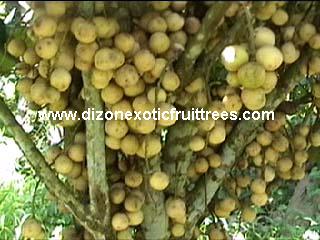One
of the recently-introduced fruits that has caught the
interest of a lot of local fruit farmers, both hobby and
commercial growers, is the Longkong, this is the variety of
lanzones that is grown commercially in Thailand and
Malaysia. It has superior eating quality; hence it has a
much higher price than the ordinary lanzones in markets
abroad where fruits are available. In the Philippines, some
traders import small quantities from Thailand which are sold
at almost unbelievable price of P360 to P400 per kilo.
 Of
course, there are some people who don't mind paying such an
exorbitant price. Some of them are gift-givers who want to
impress their recipients.
At any rate, here some updates on Longkong which could
guide local growers. Dr. Pablito P. Pamplona of the
University of Southern Mindanao in Kabacan, Cotabato, has
been undertaking trips to observe fruit farms in Thailand
and Malaysia where this fruit trees is grown commercially.
Dr. Pamplona reports that not all Longkong trees produce
superior fruits. There are cultivars that are really
superior in eating quality and there are those that are of
poor quality.
It is easy to spot the trees that are superior when
they are already fruiting. They produce big clusters of
fruits that are compact, each cluster weighing one to three
kilos. The fruits are pear-shaped with very translucent
flesh. On the other hand, the inferior Longkong produces
clusters that are loose and which are not sweet. There are
actually two type of interior Longkong in Thailand. One has
watery fruits and is called "mae". The other type produces
sour fruits almost like the local Jolo lanzones and is
called "kalamae".
The best Longkong, according to Dr. Pamplona,
originated from the Sepo district of Narathiwat province in
Southern Thailand. Fortunately, Dr. Pamplona has brought to
the Philippines the right variety which he is now
propagating in Mindanao. The variety he introduced is also
now being propagated in big number in Luzon by
Bernie Dizon
who has just obtained a new propagation area in Candelaria,
Quezon.
Meanwhile, here are the latest recommendations of Dr.
Pamplona on the growing of Longkong. Like the ordinary
lanzones, Longkong thrives in lowland tropical climate from
sea level to 600 meters above sea level. In Malaysia, he
said, it is also grown at higher elevations but the trees
have a longer juvenile period and the fruits tend to have
more seeds that are also bigger. Ordinarily, Longkong fruits
have one small seed each which is a very desirable trait as
far as consumers are concerned.
Dr. Pamplona stresses that Longkong requires partial
shading even at mature stage, especially at low elevation.
It has been observed, however, that Longkong grows well as
solo crop in the high elevation of Perak, Malaysia and near
the foot of Mt. Apo and Mt. Matumtum in Mindanao.
He says that the most common intercrops used to provide
shade are durian and rambutan in Thailand. In Malaysia,
coconut is the usual shade crop. The latest trend, he adds,
is the use of aromatic coconut (Pandan variety) for growing
with Longkong. This is a wise choice because the aromatic
coconut produces small fruits that are highly valued for
their sweet water and meat. In the Philippines, there are
already a few plantings of the aromatic coconut. One
propagator is Ven Gallego of Davao City.
Dr. Pamplona recommends the use of large planting
materials in establishing a Longkong plantation. Shade
plants such as coconut, durian, rambutan and others may be
established ahead. Otherwise, if Longkong has to be
established at the same time with the above crops, bananas
should also be intercropped to provide the necessary shade.
The ideal growing area for Longkong, Dr. Pamplona says,
is one where there's an annual rainfall of 2,000 to 4,000
millimeter a year and with a dry period of at least two
months. The dry period is needed to trigger flowering. After
a dry spell, rain or irrigation will induce flowering.
The recommended distance of planting is 6m x 6m for a
population of 300 trees per hectare. However, if the
plantation is intercropped with 50 durian trees, the
Longkong population would be only 200 per hectare. The
planting hole of large planting materials should be about 60
cm deep and 60 cm wide. |

